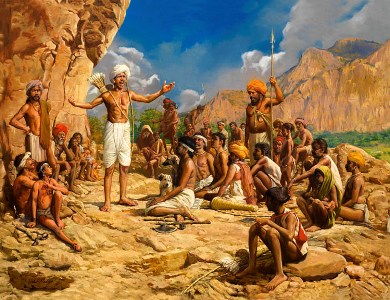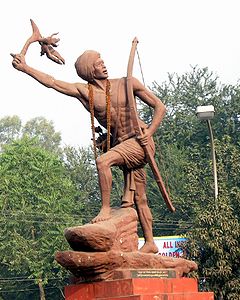Birsa Munda was born on 15 November in the year 1875 on a Thursday
 Birsa Munda (1875–1900) was an Indian tribal freedom fighter and a folk hero, who belonged to the Munda tribe, and was behind the Millenarian movement that rose in the tribal belt of modern day Bihar, and Jharkhand during the British Raj, in the late 19th century, thereby making him an important figure in the history of the Indian independence movement.
Birsa Munda (1875–1900) was an Indian tribal freedom fighter and a folk hero, who belonged to the Munda tribe, and was behind the Millenarian movement that rose in the tribal belt of modern day Bihar, and Jharkhand during the British Raj, in the late 19th century, thereby making him an important figure in the history of the Indian independence movement.
His portrait hangs in the Central Hall of Indian Parliament, the only tribal leader to have been so honoured.
Birsa Munda is named with great respect as one of the freedom fighters in the Indian struggle for independence against British colonialism. His achievements in the freedom struggle became even greater considering he accomplished this before his 25th year.
The Making of a Prophet
 Birsa’s claim to be a messenger of God and the founder of a new religion sounded preposterous to the mission. There were also within his sect converts from Christianity, mostly Sardars. His simple system of offering was directed against the church which levied a tax. And the concept of one God appealed to his people who found his religion and economical relig healer, a miracle-worker, and a preacher spread, out of all proportion to the facts. The Mundas, Oraons, and Kharias flocked to Chalkad to see the new prophet and to be cured of their ills. Both the Oraon and Munda population up to Barwari and Chechari in Palamau became convinced Birsaities. Contemporary and later folk songs commemorate the tremendous impact of Birsa on his people, their joy and expectations at his advent. The name of Dharti Aba was on everybody’s lips. A folk songs in Sadani showed that the first impact cut across the lines of caste Hindus and Muslims also flocked to the new Sun of religion. All roads led to Chalked.
Birsa’s claim to be a messenger of God and the founder of a new religion sounded preposterous to the mission. There were also within his sect converts from Christianity, mostly Sardars. His simple system of offering was directed against the church which levied a tax. And the concept of one God appealed to his people who found his religion and economical relig healer, a miracle-worker, and a preacher spread, out of all proportion to the facts. The Mundas, Oraons, and Kharias flocked to Chalkad to see the new prophet and to be cured of their ills. Both the Oraon and Munda population up to Barwari and Chechari in Palamau became convinced Birsaities. Contemporary and later folk songs commemorate the tremendous impact of Birsa on his people, their joy and expectations at his advent. The name of Dharti Aba was on everybody’s lips. A folk songs in Sadani showed that the first impact cut across the lines of caste Hindus and Muslims also flocked to the new Sun of religion. All roads led to Chalked.
Birsa Munda and his movement
The British colonial system intensified the transformation of the tribal agrarian system into feudal state. As the tribals with their primitive technology could not generate a surplus, non-tribal peasantry were invited by the chiefs in Chhotanagpur to settle on and cultivate the land. This led to the alienation of the lands held by the tribals. The new class of Thikadars were of a more rapacious kind and eager to make most of their possessions.
In 1856 the number of the Jagirdars stood at about 600, and they held from a village to 150 villages. By 1874, the authority of the old Munda or Oraon chiefs had been almost entirely effaced by that of the farmers, introduced by the superior landlord. In some villages the aborigines had completely lost their proprietary rights, and had been reduced to the position of farm labourers.
To the twin challenges of agrarian breakdown and culture change, Birsa along with the Munda resp onded through a series of revolts and uprisings under his leadership. The movement sought to assert rights of the Mundas as the real proprietors of the soil, and the expulsion of middlemen and the British. He was treacherously caught on 3 February 1900 and died in mysterious conditions on 9 June 1900 in Ranchi Jail. He didn’t show any symptoms of cholera. Though British government declared that he died because of cholera. Though he lived for a very short span of 25 years, he aroused the mind-set of the tribals and mobilized them in a small town of Chhotanagpur and was a terror to the British rulers. After his death the movement faded out. However, the movement was significant in at least two ways . First it forced the colonial government to introduce laws so that the land of the tribals could not be easily taken away by the dikus. Second it showed once again that the tribal people had the capacity to protest against injustice and express their anger against colonial rule. They did this in their own way, inventing their own rituals and symbols of struggle.
onded through a series of revolts and uprisings under his leadership. The movement sought to assert rights of the Mundas as the real proprietors of the soil, and the expulsion of middlemen and the British. He was treacherously caught on 3 February 1900 and died in mysterious conditions on 9 June 1900 in Ranchi Jail. He didn’t show any symptoms of cholera. Though British government declared that he died because of cholera. Though he lived for a very short span of 25 years, he aroused the mind-set of the tribals and mobilized them in a small town of Chhotanagpur and was a terror to the British rulers. After his death the movement faded out. However, the movement was significant in at least two ways . First it forced the colonial government to introduce laws so that the land of the tribals could not be easily taken away by the dikus. Second it showed once again that the tribal people had the capacity to protest against injustice and express their anger against colonial rule. They did this in their own way, inventing their own rituals and symbols of struggle.
Commemoration
He is commemorated in the names of the following institutions: Birsa Institute of Technology Sindri, Birsa Agricultural University, and the Sidho Kanho Birsha University. The Birsa Munda Athletics Stadium, Birsa Munda Airport,Birsa Institute Of Technical Education (B.I.T.E. Ramgarh) and the Birsa Seva Dal also pay homage to his name..
